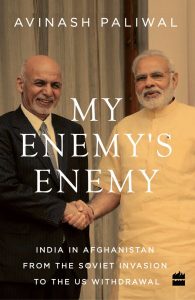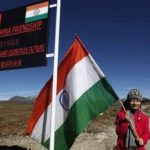
Publisher : HarperCollins; 1st edition (29 September 2017)
Language : English
Hardcover : 400 pages
ISBN-10 : 9789352772681
ISBN-13 : 978-9352772681
Item Weight : 456 g
Asia has been the fulcrum of global power play in recent decades especially with the usage of terms such as the ‘Asian century’, Asia has become the land of rising powers who have a greater say in determining the global world order. The term ‘rising power’ has been associated with India due to its growing regional and global importance. The author in his book highlights India’s rising power status by decoding the Indian foreign policymaking process specifically towards Afghanistan. Afghanistan, which has been a theatre of conflict for decades is situated at the heart of Asia and is of critical strategic importance for India as any instability in Afghanistan impacts Indian security and foreign policy.
The author divides his book into three segments: debating neutrality, debating containment and debating engagement. The book provides a trajectory of India-Afghanistan relations right from tracing the civilizational history shared by the two nations till the USA’s withdrawal decision. The author provides an extensively researched picture of India’s policy-making circuits and he divides them into two groups, the ‘conciliators’ and the ‘partisans’. Conciliators are a group of policymakers who focus on building goodwill among the people of Afghanistan and politically engaging with every entity, including the Taliban. Conciliators believe that not engaging with pro-Pakistan Afghan factions is not a viable option for India as it would hinder India’s influence and engagement in Afghanistan. The other group of partisans, follow the stand of non-engagement or a containment policy towards pro-Pakistan factions. They rather focus on building ties with those factions who are not dependent and influenced by Pakistan and empower these factions by mobilizing international support for them. Both these groups in the Indian policymaking circles have Pakistan at the core of their decision-making process but have different means to address Pakistan.
The argument put forward in the book on India’s Afghanistan policy is addressed in three specific factors, the first factor aims at striking a balance between Afghanistan and Pakistan. Afghanistan’s dependence on Pakistan is not in India’s strategic interest, firstly because, Pakistan’s security agencies use Afghanistan to cause security challenges for India especially in Kashmir. Secondly, Pakistan’s dominance in Afghanistan hinders India’s connectivity to the Central Asian Region. The second factor is the international political environment, India’s policy towards Afghanistan is focused on limiting Kabul’s dependence over Pakistan, and therefore, India supports a multi-stakeholder presence in Afghanistan. The partisans and conciliators in India have changed according to the evolving international political environment, often bandwagoning with the international actor who has a greater role in Afghanistan, for example, Indian officials were reluctant with Hamid Karzai’s leadership in Afghanistan due to his connections with Pakistan, but ultimately supported his rise. While at the same time India has stood firm to its principles and opposed the Mujahideen interim government in 1990 and went against the international consensus. The third factor, the domestic politics in Afghanistan has always influenced India’s policy, India has maintained cordial relations with both Ghani and Karzai government’s, but has also found it difficult to engage with all the factions in Afghanistan.
Debating Neutrality
In the first part of the book, the author gives a detailed account of the cultural and historical ties shared between the two nations and also focuses on the political dynamics shared between the two from 1947 to 1990. The Treaty of Peace and Friendship signed in 1950 between India and Afghanistan and the Bandung conference in 1955 provided a framework to develop bilateral ties between the nations. India’s engagement with Afghanistan stood strong in the 1960s with Cold War being at its peak and the imbalance and security threat India faced with Pakistan and China did not hamper the relations between New Delhi and Kabul. However, the author points out that India’s dependence on the Soviet Union from the 1970s fractured the relations between Afghanistan and India, as India did not challenge the Soviet military intervention in Afghanistan. Even with the Soviet withdrawal from Afghanistan India was not able to form a definitive policy towards Afghanistan as it did not recognize the Mujahideen government as Afghanistan’s government in exile. India’s reluctance to question the Soviet intervention and at the same time following the principles of neutrality affected India in gaining a stronghold in Afghanistan.
Debating Containment
The late 1990s saw a phase of partisan dominance in the Indian policymaking circles, with India denying asylum to Najibullah fearing a rise in the subcontinental rivalry, India’s policy towards Afghanistan had Pakistan in the core of it. As the author writes, the Afghanistan conflict had become a byproduct of the India-Pakistan rivalry, as the policymakers in India viewed Afghanistan from the security threats emanating from Pakistan and it was the same case on the Pakistani side. With Najibullah’s death and the disintegration of the Soviet Union, India had to engage with the Mujahideen as any more distance from the Mujahideen would have isolated India from Afghanistan. However, this engagement was short-lived with the rise of the Taliban in 1996 which had no international support, unlike the Mujahideen. With the Taliban’s rise, the Indian desires in Afghanistan were weakened as the balance of power favoured Pakistan. The dynamics in Afghanistan changed post 9/11, which was seen as a watershed moment in US policy towards Afghanistan and terrorism. The ‘war on terror’ was carried out by the USA, which ended the Taliban regime and gave rise to the United Front and Bonn Conference in 2001 set Hamid Karzai as the interim president.
Debating Engagement
India’s engagement with Afghanistan was on a rise with Karzai coming into power, Karzai had struck a balance with both the partisans and the conciliators. Afghanistan and India signed the Strategic Partnership Agreement in 2011, allowing India to support Afghanistan in the security sector along with other areas of cooperation. The agreement gained greater significance as Karzai had rejected a similar agreement presented by Pakistan and chose to go ahead with India. This period also saw the rise of conciliators in India, as India adopted a dual approach towards the Taliban, by publicly criticizing them and privately engaging with some factions of the Taliban. The NATO withdrawal from Afghanistan concerned India as complete withdrawal would create a political meltdown in Afghanistan.
Conclusion
The author, provides a definitive account of India-Afghanistan relations, tracing back to the shared civilizational history till the present times. The book helps in analyzing the Indian policy towards Afghanistan since 1947 and also provides three major drivers that shape the policy. In the present climate with the Taliban’s takeover in Afghanistan, India’s policy would focus on safeguarding its assets in Afghanistan and with India formally meeting with the Taliban it showcases that India does not aim to limit its engagement in Afghanistan. The second and third parts of the book on debating containment and debating engagement become an important read to understand India’s position on the Taliban and its engagement with some factions of Taliban over the years. As Afghanistan’s political future and stability continue to be debated due to the present turmoil, this book serves as an extremely resourceful text in understanding India’s policy towards Afghanistan.













